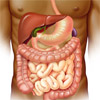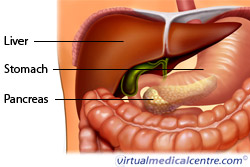Pancreatic Cancer
Cancer and the body
Cancer overview
 | Cancer, a condition of abnormal cell growth, is the second most common cause of death in developed countries. Normal cell growth is a carefully regulated process. Cancer cells replicate in an uncontrolled manner, and can move from one part of the body to another. |
For more information, see Cancer: Overview.
Anatomy of the gastrointestinal system
 | The gastrointestinal tract (GIT) consists of a hollow muscular tube starting from the oral cavity, where food enters the mouth, continuing through the pharynx, oesophagus, stomach and intestines to the rectum and anus, where food is expelled. |
For more information, see Gastrointestinal System.
Types of pancreatic cancer
Adenocarcinoma of the pancreas
 | Commonly, the term pancreatic cancer refers to pancreatic adenocarcinoma, which is a cancer of the cells that make up the ducts in the pancreas. Pancreatic adenocarcinoma occurs when these cells grow in an uncontrolled, irregular and prolific manner. Although not one of the most common types of cancer in Australia, accounting for only 2.3% of all cancers in 2007, pancreatic cancer is associated with an extremely high mortality rate. |
For more information, see Adenocarcinoma of the Pancreas.
Pancreatic neuroendocrine tumour (PNET)
 | Pancreatic neuroendocrine tumours (PNETs) are a group of rare tumours that develop from specialised cells known as neuroendocrine cells within the pancreas. PNETs are rare tumours, with approximately 1 in 100,000 people being affected per year in the general population. A large proportion of PNETs don’t cause symptoms and grow very slowly. |
For more information, see Pancreatic Neuroendocrine Tumour (PNET).
Investigations
Genetic typing of cancers
 | Individuals that inherit a genetic mutation from their parents are at a greater risk of certain types of cancers. Familial cancer syndromes are the group of cancers where patients inherit genes that do not function properly, increasing the risk of developing cancer. |
For more information, see Genetic Typing of Cancers.
Treatments
Biological therapy (Biotherapy)
 | Biological therapy, or biotherapy, immunotherapy or biological response modifiers, are gaining increasing prominence as anti-cancer agents. They may be used either alone or in combination with traditional anti-cancer treatments such as chemotherapy. |
For more information, see Biological therapy (Biotherapy).
Dates
Posted On: 12 October, 2011
Modified On: 20 February, 2014
Tags
Created by:

 Login
Login















